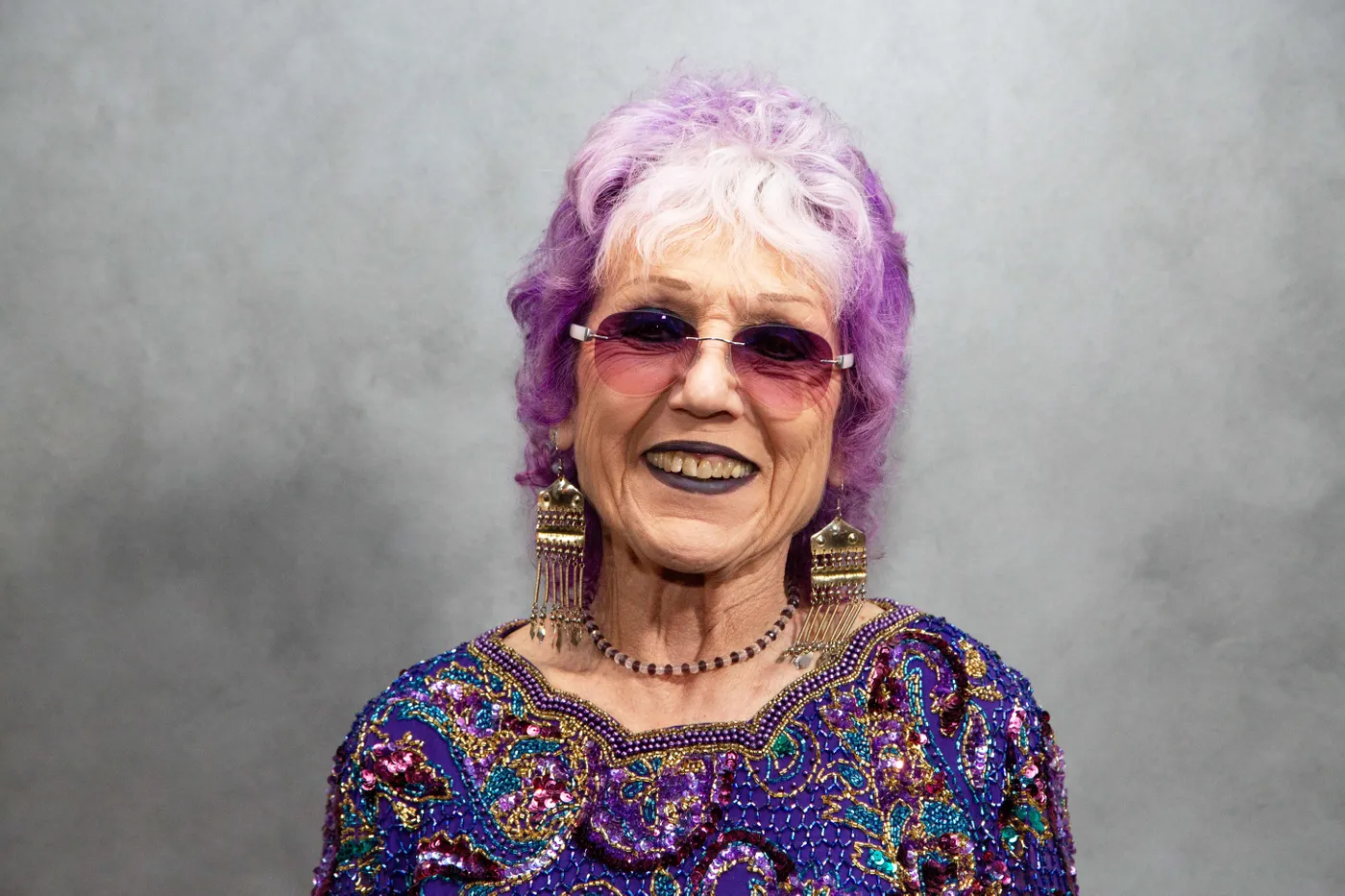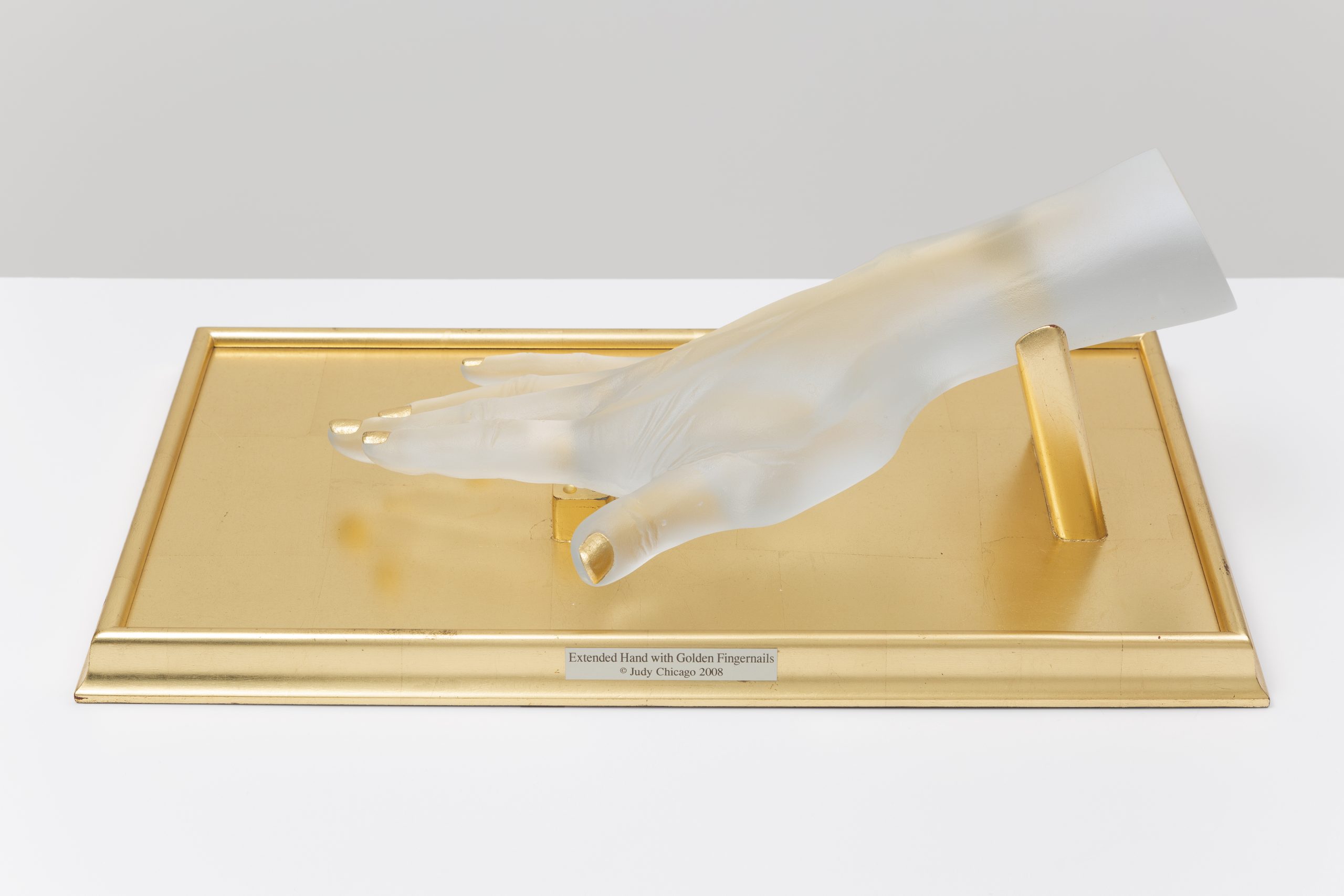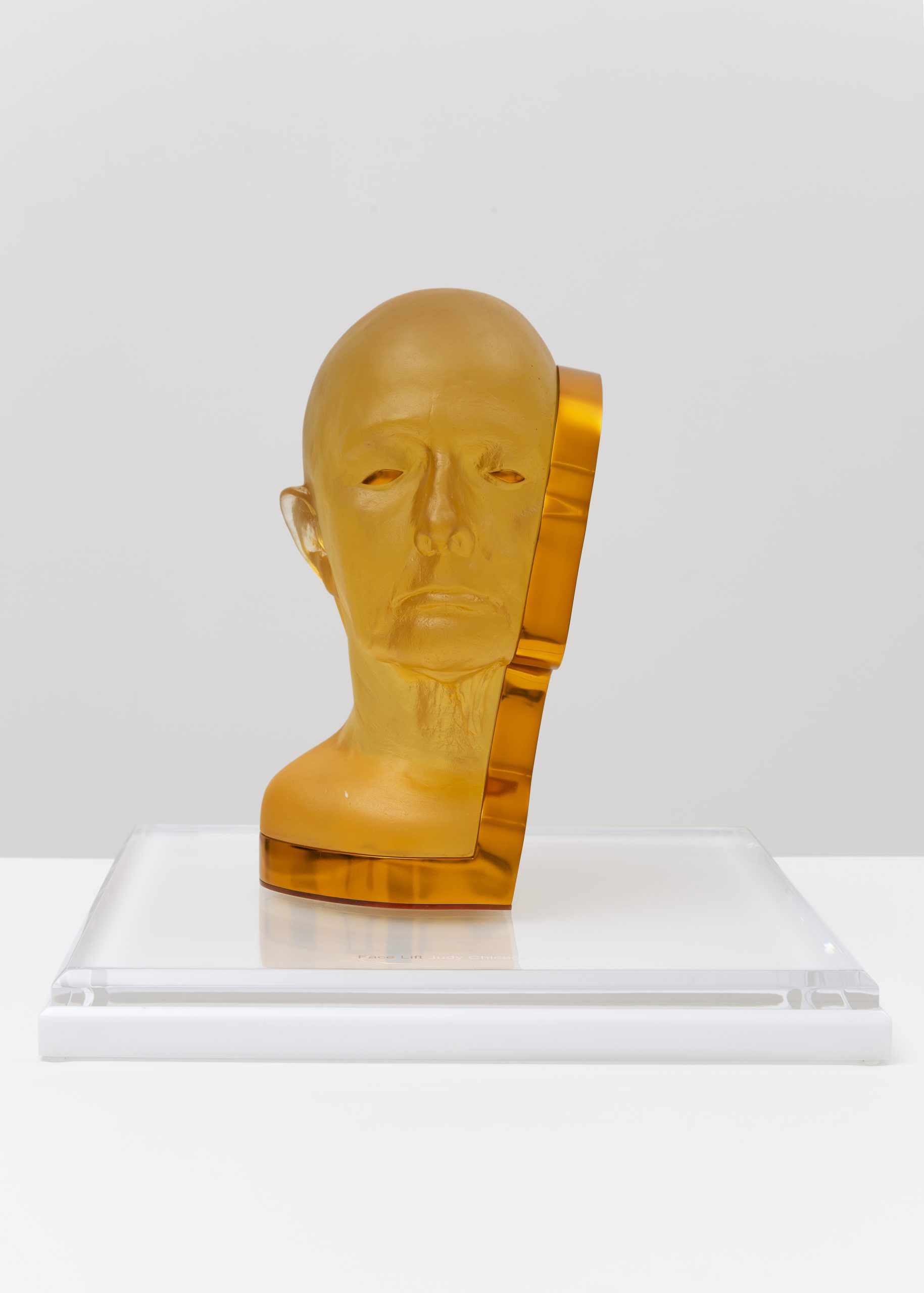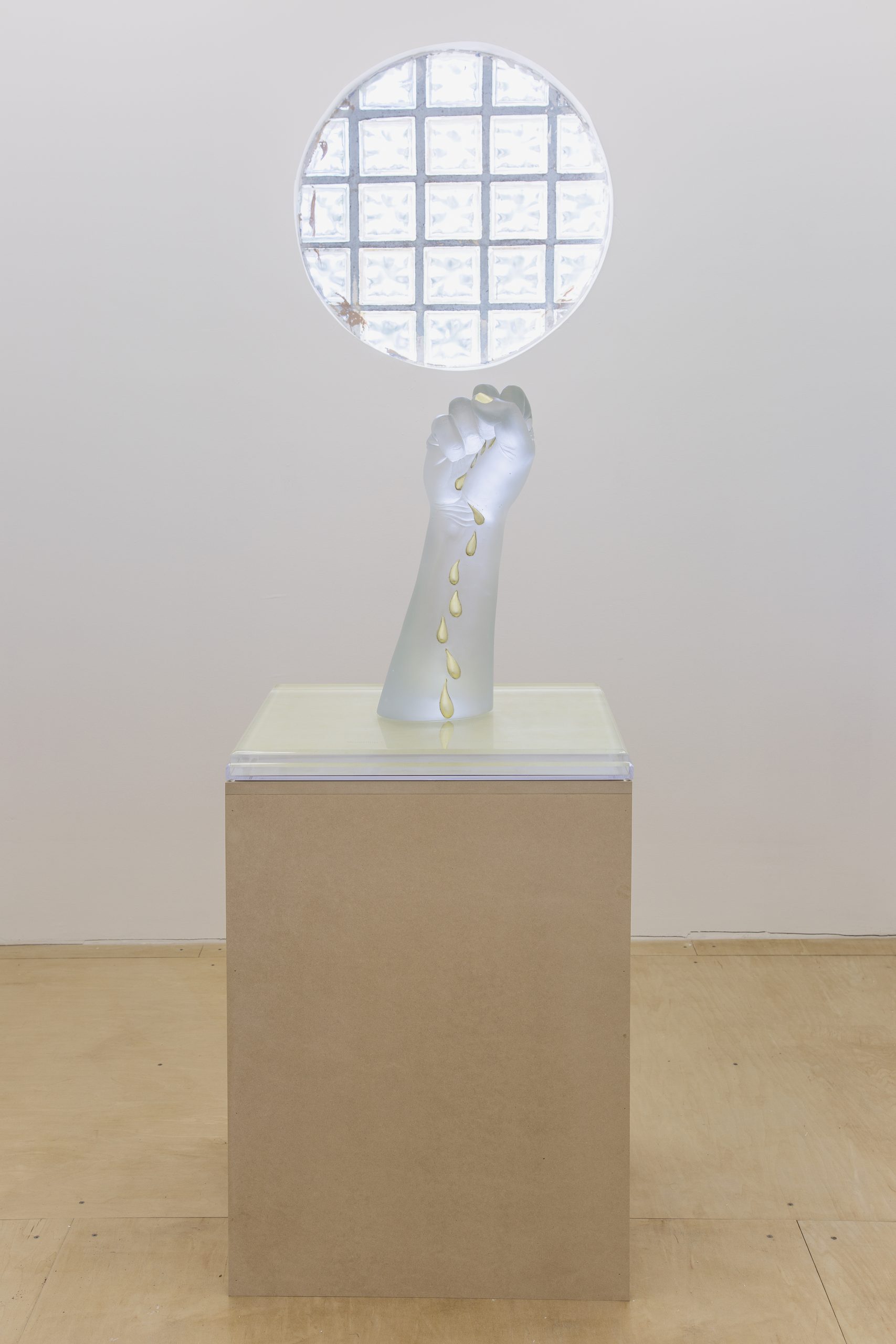Judy Chicago Is Tired of The Dinner Party

Judy Chicago is in her early 80s now but remains entirely committed to the bit, showing up to her Art Basel exhibition with indigo hair and a sequin-spangled top. She’s here for the opening of her show — Judy Chicago in Glass — which runs through January 15 and features a collection of lesser-known glasswork that dates back to the early aughts.
“For a long time, I went around saying, ‘I can hardly wait until the body of my work emerges from the shadow of The Dinner Party,’” she tells me as we wander through Nina Johnson’s small, bright gallery. “Like other bodies of my work, they’re not known,” she says, gesturing to the surrounding collection of glass sculptures, almost all human body parts: hands, fists, busts, and Toby mugs in brass, glass, and porcelain. Her husband, photographer Donald Woodman, a huge man wearing a shirt with Chicago’s face on it (and who has a rainbow manicure that matches his wife’s) harrumphs in agreement.
We’re all chatting about how the inside view of one hand sculpture — a frosted glass piece with a translucent tunnel leading from arm to hand (pictured above) — brings to mind images of sperm traveling through a vaginal canal when two women in the gallery pretty much prove Chicago’s point. After asking her to pose for photos, one of them (who had been considering a $95,000 glass fist) asks Chicago if she’s “selling any plates,” referring to renditions of her Dinner Party molds. The woman seems desperate, and Chicago, with just a touch of good-natured exasperation, directs her to another of her gallerists to “go find something she likes.”
You’re a rock star. Does it get old?
Oh yeah.
How has Basel been for you this year?
A lot of selfies.
Ah! Do you hate it?
I appreciate that there are so many — particularly young — women for whom my work has been important. That’s what I set out to do: to make sure that young women didn’t have my experience, which was no role models, no women artists to look up to.
Are there any artists whom you come here to see yourself? Ones that you’re interested in?
I’m particularly fond of an artist named Rose Simpson. She’s a Native American artist who shows with my gallerist, Jessica Silverman. And there was a beautiful Nick Cave piece at Basel, but you don’t go to Basel to see meaningful art.
Why do you come to Basel?
I had to come to Basel for the opening of my show. Where do you live?
New York.
Why do you come to Basel?
For the parties. This is your first glass show?
Yeah. I started working in glass in 2003.
Been a while.
Until recently, people were simply not interested in the range of my career. Then I had the retrospective [“Judy Chicago: A Retrospective”] that opened in the fall at the de Young. It completely blasted open my career.
Yeah. Well, that woman — she asked for the plates just then.
Oh, everybody always wants the plates. That’s not new.
This exhibition includes a brand-new work, Mortality in Glass, recast from the bronze relief you made for “The End.” It’s the same image, but made in pinkish glass, and feels completely different from the bronze. Why did you decide to cast it in glass?
When you change materials, the meaning changes. The bronze, it evokes mortuary reliefs, marble death masks. But glass, it makes the fragility of death, the vulnerability of it, more evident. We live in a culture that denies death and tries to hide it. I wanted to understand it, and face it with some level of dignity, and not end up terrified.
Did it work?
Yeah, I think so. We’ll see.
At Art Basel this year, I keep hearing about this NFT thing. What do you think about them?
Oh, I’m not interested.
Not interested? That’s your comment on it?
We saw the NFT installation booth at Art Basel. It was nothing.
Can you tell me what it is?
It is art. It’s entertainment.
It’s entertainment?
It’s for people who are used to gaming and don’t know the difference between a digital and a real image. Actually, when we were in San Francisco, we were staying downtown, and we went to buy a tangible bottle of wine for a tangible dinner party before COVID, and Donald pulled out cash, and the guy looked at him like, What is this?
Everything is in the cloud.
There is a big divide between our generation and younger people who have lived their lives in a digital universe, whereas we have lived our lives in real life. The fact that people can see my handwriting, and they can see the pen strokes with the glass paint — that’s hours and hours of human investment. You don’t see any of that on a screen. Here, you can feel the energy that’s transmitted from a real object. I’m sorry, there is no NFT that’s going to give me that.
Well, I did one adventure into gaming. I have an app.
For what? What does it do?
For my smoke pieces.
[Woodman and Chicago demonstrate Rainbow AR, an app that causes colored smoke to fill the room in which your phone camera is pointed. They seem pretty excited about it, all things considered.]
Before I let you go, I want to take it back to The Dinner Party. Has your relationship with it been a contentious one?
Let’s put it this way: Normally when an artist finishes a work, they’re finished with it. Well, I wasn’t finished with The Dinner Party for 30 years because one of my goals was seeing that it would be permanently housed. Having to stay connected to a work for so long, being so closely identified with it and then having it block out the rest of my work? Complicated.
Fair enough.
On the other hand, we were at a dinner the other night, and this woman came up to me and talked about what it meant to her to bring her daughter and her grandchildren to see it and to teach them about all these different women. So The Dinner Party continues to have its own life. The girls have their own home now — I’m like, Go and be well.
Okay, I think —
That was supposed to be the last question.
Well, it was, but I want to ask you one more thing: As someone who’s thought about mortality for so many years, what do you think happens to us when we die?
I think we die.
And we just return to the earth from whence we came?
Unless you’re put into a stone mausoleum and then you may return to the earth, but then there’s this big chunk of whatever. I’m really all for green burial. My idea, we have a cat cemetery; I want to be buried with our cats.
With the cats?
With the cats.
Amazing.
And then Donald — Donald wants to be buried on top of me. Don’t print that, though. [Laughs.]


